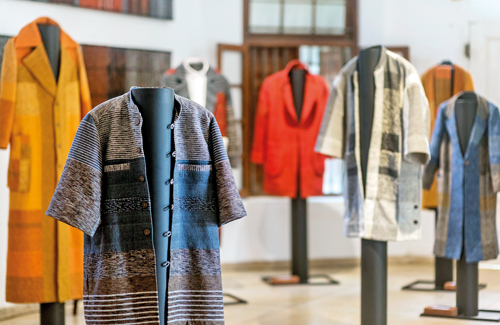Mother and daughter factor behind Woven Structures

A happy partnership: Marisa and Marie Gnanaraj. Pic by Ishanka Sunimal
Marie Gnanaraj is 69 years old, and Marisa Gnanaraj is 38 years old. Officially, they’ve been collaborators for six years. Unofficially? It’s more like Marisa’s whole life. “Mum has been making fabric for the longest time, I have literally grown up with it,” says Marisa remembering the loom in their home, and how she and her brother were sometimes recruited to help Marie create her stunning handloom fabrics. “Without realising it, I learned things. It was like breathing, like second nature.”
Woven Structures is their first exhibition together and it will be on at Barefoot till July 18. A collection of coats with gorgeous detailing, the exhibition is the latest in a series of collaborations between mother and daughter which included 2011’s Juxta-Op and 2017’s Horizon Infinity, both released under Marisa’s label MFact. Horizon Infinity was nominated and shortlisted for the Beazley Design of the Year and two coats from the collection went on to be displayed at the London Design Museum. You’ll see a few of those pieces at Woven Structures as well.
The exhibition draws on old memories, inspired by the years when Marisa was young and Marie built her own home and saw those of family members come up around them. Where another might have resented the dust and the noise, Marie was instead absorbed by the colours and the textures: smooth grey cement and rough brick walls; water tanks and asbestos roofs with rusty gutters. The alchemy of her artistry lies now in the conversion of those impressions of mundane objects into densely textured fabrics dominated by a palette of grey, black, red and brown.

Style and structure: The coats on display at Barefoot. Pic courtesy Dominic Sansoni
The fabric is Marie’s domain. While the two collaborators often have a meeting to discuss a new line, their responsibilities have always been relatively compartmentalised, their approaches distinct. So, after an initial conversation, Marisa leaves the cloth in her mother’s capable hands, only taking over when the bolts are complete. Marisa then works on the shell of the garment, bringing Marie back in when she has a clear structure ready to view. Though Marie never learned to sew, she has an eye for lines and movement, and her feedback helps Marisa refine her designs.
“Their generation were mostly self-taught, and they work on instinct,” says Marisa, talking about what she likes to describe as her mother’s sixth sense. Her own approach is more structured and informed in part by her years of study at Raffles in Bangkok.
However, Marisa relies on a formal approach only up to a point – as exemplified by decisions she made early in her career. As a young fashion graduate just starting out, she was advised by everyone around her to start by getting a job in Sri Lanka’s garment industry. Convinced it would kill her creativity, Marisa decided to launch her own line instead. Looking back, she is forever grateful to Dominic Sansoni for his offer to put MFact’s first collection on sale in Barefoot and that his invitation came with no strings attached. She also knew she would have fabric being designed just for her by Marie who had been weaving at least since 1975, had apprenticed with Barbara Sansoni and was by this point Barefoot’s principal designer.
For her part, Marie watched with deep pleasure as her daughter came into her own. There had been a few years there, where it wasn’t clear to anyone, including Marisa herself, what direction her career would take. She had worked in journalism and taken on a stint as an air stewardess; she had been a television presenter and a compere. When Marisa began acting, Marie was forthright in her opinion that it was a bit of a dead end, a verdict the two still laugh about.
Marie was with Marisa when she went to look in on a jewellery designing course at a local institute and found only fashion design was on offer. She was glad when her daughter picked it, but had no inkling just how well Marisa would take to it. “When I saw how she turned things around, it was really magical for me,” Marie recalls. And when it came to design, she felt that Marisa’s thoughtful, bold approach added a new dimension to her own textiles, that it took them to another level.
When it came to working on Woven Structures, Marisa admits to being nervous that people would question the need for a collection of outwear in a Sri Lankan context but she feels the coats are the perfect medium in which to display Marie’s genius with textiles. The handlooms they’ve used are heavy and structured, and lend themselves to the clean geometric lines of these coats. When on display, it feels like each is a work of art, as much as any tapestry or swathe of fabric that Marie ever designed.
Reflecting on what they have achieved, Marie is already looking ahead, filled with ideas for what she will offer Marisa next. She says their professional relationship operates on complete trust. “Really, I try not to interfere at all,” says Marie, utterly confident in her daughter’s skill. For her part, Marisa is just grateful to have found such a wonderful collaborator in her mother. “She is the real magician here, and I am just the sidekick.”


